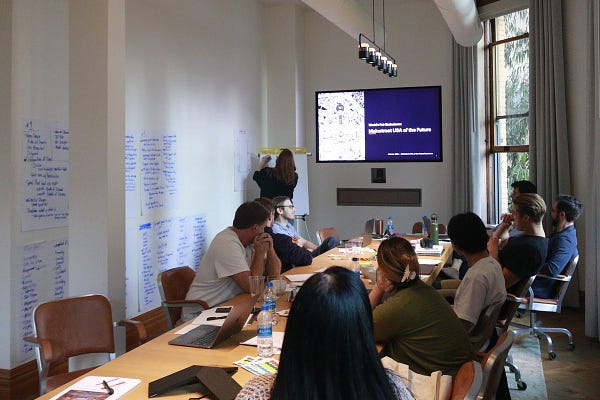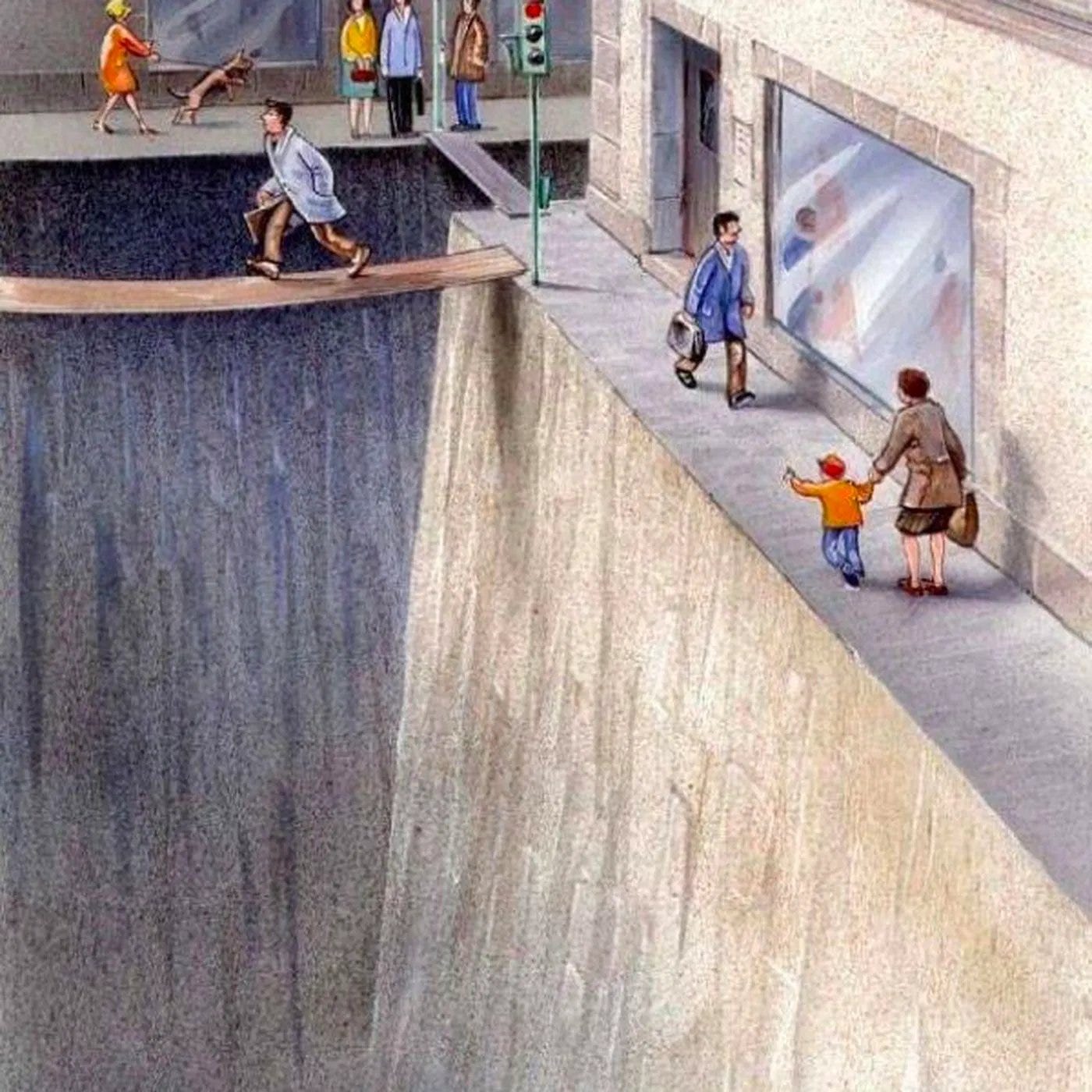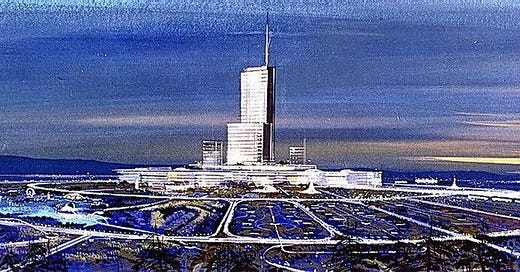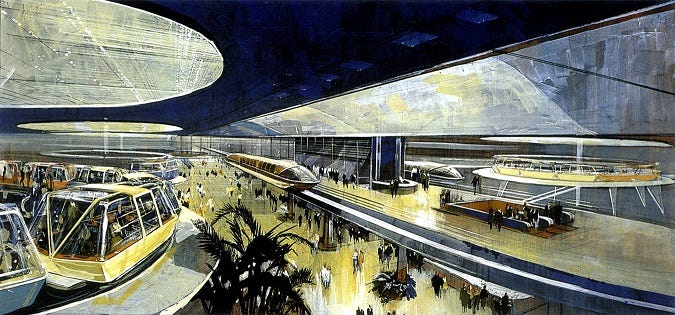This is a weekly newsletter about the art and science of building and investing in tech companies. To receive Investing 101 in your inbox each week, subscribe here:
Bit of a delayed post this week because I spent some time with my family in Disneyland over the last few days. Getting to go to Disneyland has always had a special place in my heart. Not just because I’m a sucker for over-priced churros and cartoons. But because I've had a strange obsession with city building since I was pretty young.
Growing up, my family would spend summers in Luna, New Mexico; a tiny little town in the middle of nowhere between Arizona and New Mexico where my Grandma grew up, and my family helped settle the town in the 1800s. When we would drive there from Albuquerque, my Dad would talk about all the little towns we drove through. He'd ask the question, "what makes a city?" And we'd talk about how communities get built around natural resources, large factories, universities, coal mines, and on and on. I became obsessed with the idea of why people come together.
As I got older, this idea of "city building" became a portfolio idea and evolved to include concepts like urban planning and sociology. The same wonder I felt thinking about city building, I felt the first time I went to Disneyland walking down Main Street. Little did I know, this wasn't a fluke. Walt Disney was just as obsessed with city building.
A few years ago, I read a book called Walt Disney and the Promise of Progress City, a book focused on unpacking Walt Disney's obsession with building the city of the future. It's a tragedy that his vision for EPCOT was never fully realized.
"Walt had said, '[EPCOT] will be a planned, controlled community; a showcase for American industry and research, schools, cultural, and educational opportunities. One of our requirements is that the people who live in EPCOT must help keep it alive. Everyone who lives here will have a responsibility to help keep this community an exciting living blueprint of the future.'"
So, other than sharing a travelogue of my family vacation, why am I talking about city building and Disneyland? In investing, people often use the phrase, "dream the dream." Another way of putting it? "What do I have to believe for this to go super well?" The bull case.
I've written several times before about the importance of well-reasoned intellectual honesty and pragmatism. But the other side of the coin is often under-appreciated. The world needs more founders and investors who are willing to dream bold and ambitious dreams. And walking around Disneyland, thinking about experimental prototype communities of tomorrow, I couldn't help but think about what it means to "dream the dream."
Dreaming: a Learnable Skill
There is so much hype in startups, especially over the last few years. I welcome a healthy economic correction to bring people back down to earth. But my fear is two-fold: (1) we'll forget how to dream entirely, and (2) we'll throw the baby out with the bath water and disregard the true visionaries along with the hucksters.
I've written before about the storytelling of investing, and how important a narrative is in evaluating an investment. Dan Loeb said being an investor "is to live constantly at the intersection of story and uncertainty." But unpacking that story comes later; dreaming the dream is letting yourself optimistically imagine what could be true, and then seek to help bring it about.
Some people might think this is common sense. "We're working in the tech industry. Inventing the future is what we do." But in reality, some people approach their work in technology (whether as a founder, operator, or investor) a lot like a commodities trader; just managing risk and exposure. Very little imagination involved. Instead? Curiosity must be learned.

Any attempt at honing curiosity, and imagination, has been a catastrophic failure. There is a breadth of research on the topic of curiosity, and how it's being weeded out in formal education. In the book, Promise of Progress City, the author describes Walt Disney's approach to imagination this way:
"Walt wanted to spark the imagination of others and give them the tools to work together to make things better than the sum of their parts."
The ability to spark people's imagination, and push them to create is a super power. Being able to spark that same creativity in yourself is a critical skill. Things like space exploration or generative AI are so awe-inspiring because they represent the unknown. And instinctually, we yearn for the unknown. We seek to be surprised.
As I reflected back on the lessons from Walt Disney, I sat down and reviewed some of my notes around the patterns that he demonstrated in his attempt to built the prototypical community of the future.
The Disney Daydream
Walt Disney, like any notable character in history, had plenty of flaws. There are criticisms of both his historical biases, and reflections on his "idealistic" view of community building that didn't always reflect the reality of built space. But anyone who has walked through some of the spaces that Walt Disney helped create can get a sense of the imagination that went into those creations. Here are a few of the things that struck me about his unique brand of dreaming.
Being Observant
The most curious people I know are constantly paying attention to how things work. Creativity is often remixing the things around us, but in order to remix we have to experience. We take in information, experiences, and perspectives, and then roll them into something new. “The whole is greater than the sum of the parts.” Walt Disney did this by traveling frequently:
"Always curious, Walt was frequently inspired by his trips abroad, and he brought back ideas that he would later integrate into Disneyland and his other projects. The trips expanded his vision; they got him away from the stress at the studio and gave him a chance to travel, to observe, and to think."
Alan Rickman said something similar when asked about what advice he would give to aspiring actors:
"Forget about acting. Whatever you do as an actor is cumulative. Go to art galleries, listen to music, know what's happening on the news, in the world, and form your opinions, develop your taste and judgement. So that when a quality piece of writing is put in front of you your imagination, which you've nurtured, has something to bounce off of."
Yet another observant genius (and remixer) was Leonardo Da Vinci. In Walter Isaacson's biography of Da Vinci, he emphasized the artist's ability to observe as one of his ultimate skills; something that fed every other aspect of his creativity and vision.
"Observe. Leonardo's greatest skill was his acute ability to observe things. It was the talent that empowered his curiosity, and vice versa. It was not some magical gift but a product of his own effort."
Expose Yourself To The Best Ideas
At first glance, this might feel like a repeat of being observant. But where being observant is somewhat passive, this is something very active. As we go about our lives, we should be observant to more effectively remix relevant aspects of life to create the best "new thing." But we need to proactively seek out the best ideas; the centers of gravity for creativity and problem solving.
For Walt Disney? Those ideas often came from the World's Fair:
"A century before there was Disneyland, there were World’s Fairs. Walt was influenced by World’s Fairs, and he in turn influenced a number of these major global events. His experience with World’s Fairs helped feed his interest and understanding of city planning; many elements of the Disney theme park experience are rooted in these spectacular temporary international events."
There is a shortage of breath taking collections of the world's best ideas. Honestly, one of the best places for this is on Twitter or TikTok where you can often be exposed to the best (and worst) things that people are working on.
Some people are setting out to create new experiences to curate the best ideas the world has to offer, like Cameron Wiese who is building World's Fair Co. But there is plenty of need for aggregators of the very best imagineering that is taking place around the world, and across disciplines.


Build In People's Lives
Dreaming the dream is often done most poorly when it starts where we wish people were, rather than where they are. You can design all the idealistic utopian dreams to your hearts desire. You can pave that path, but the question is whether people will walk down it?
People will walk where it most suits them. The job of imagining the world is fitting progress around the very human (and imperfect) behavior of the average person. Many people would point to Walt Disney's visions for a city as "too impractical," or something that no one would want. But look at some of the things we was most focused on. One example? Cars. While he certainly wasn't against automobiles, he recognized even in the 60's that they became too pervasive too quickly.
“I would like to be part of building a model community, a City of Tomorrow, you might say, because I don’t believe in going out to the extreme blue-sky stuff that some architects do. I believe that people still want to live like human beings. There’s a lot of things that could be done. I’m not against the automobile, but I just feel that the automobile has moved into communities too much. I feel that you can design so that the automobile is there, but still put people back as pedestrians.”
In the designs for EPCOT, he built a hub-and-spoke model with public transit throughout. People could live in an outer circle, shop in a middle circle, and work in an inner circle, using "People Movers" to get anywhere in the city.
Any automobile traffic would happen underground, away from pedestrian traffic. I don't know about you, but when I think about how today's cities work, I think that dream sounds pretty appealing.

What Does This Mean For Venture?
I love enterprise software. I have always loved the idea of understanding a problem that a user has, and then solving that problem with a purpose-built tool. I don't want to diminish the impact that enterprise software is having on any number of industries. But there is so much more that we can be building.

What are the markets that no one cares about? What are the industries under the radar? What are the products that people are too afraid to tackle (whether because they're too difficult? Too controversial?)
We need more people to tackle legitimate solutions to climate change (like carbon removal), AI in military defense, space exploration and manufacturing, CRISPR and genetic editing, and so much more.
Dreaming the dream doesn't have to mean "deep tech." But there could be a lot more science fiction fans in venture than there currently are. Maybe the world does need another corporate card because it solves problem XYZ. And that's great! Dreaming the dream is about imagining the future you want to exist, and then working to help bring it about.
Thanks for reading! Subscribe here to receive Investing 101 in your inbox each week:








Your writing is brilliant and inspiring. Thank you.